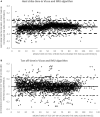Validation of a Step Detection Algorithm during Straight Walking and Turning in Patients with Parkinson's Disease and Older Adults Using an Inertial Measurement Unit at the Lower Back
- PMID: 28928711
- PMCID: PMC5591331
- DOI: 10.3389/fneur.2017.00457
Validation of a Step Detection Algorithm during Straight Walking and Turning in Patients with Parkinson's Disease and Older Adults Using an Inertial Measurement Unit at the Lower Back
Abstract
Introduction: Inertial measurement units (IMUs) positioned on various body locations allow detailed gait analysis even under unconstrained conditions. From a medical perspective, the assessment of vulnerable populations is of particular relevance, especially in the daily-life environment. Gait analysis algorithms need thorough validation, as many chronic diseases show specific and even unique gait patterns. The aim of this study was therefore to validate an acceleration-based step detection algorithm for patients with Parkinson's disease (PD) and older adults in both a lab-based and home-like environment.
Methods: In this prospective observational study, data were captured from a single 6-degrees of freedom IMU (APDM) (3DOF accelerometer and 3DOF gyroscope) worn on the lower back. Detection of heel strike (HS) and toe off (TO) on a treadmill was validated against an optoelectronic system (Vicon) (11 PD patients and 12 older adults). A second independent validation study in the home-like environment was performed against video observation (20 PD patients and 12 older adults) and included step counting during turning and non-turning, defined with a previously published algorithm.
Results: A continuous wavelet transform (cwt)-based algorithm was developed for step detection with very high agreement with the optoelectronic system. HS detection in PD patients/older adults, respectively, reached 99/99% accuracy. Similar results were obtained for TO (99/100%). In HS detection, Bland-Altman plots showed a mean difference of 0.002 s [95% confidence interval (CI) -0.09 to 0.10] between the algorithm and the optoelectronic system. The Bland-Altman plot for TO detection showed mean differences of 0.00 s (95% CI -0.12 to 0.12). In the home-like assessment, the algorithm for detection of occurrence of steps during turning reached 90% (PD patients)/90% (older adults) sensitivity, 83/88% specificity, and 88/89% accuracy. The detection of steps during non-turning phases reached 91/91% sensitivity, 90/90% specificity, and 91/91% accuracy.
Conclusion: This cwt-based algorithm for step detection measured at the lower back is in high agreement with the optoelectronic system in both PD patients and older adults. This approach and algorithm thus could provide a valuable tool for future research on home-based gait analysis in these vulnerable cohorts.
Keywords: Parkinson’s disease; accelerometer; gait analysis; home-like activities; older adults; turning.
Figures




Similar articles
-
Algorithm for Turning Detection and Analysis Validated under Home-Like Conditions in Patients with Parkinson's Disease and Older Adults using a 6 Degree-of-Freedom Inertial Measurement Unit at the Lower Back.Front Neurol. 2017 Apr 10;8:135. doi: 10.3389/fneur.2017.00135. eCollection 2017. Front Neurol. 2017. PMID: 28443059 Free PMC article.
-
Validation of a Lower Back "Wearable"-Based Sit-to-Stand and Stand-to-Sit Algorithm for Patients With Parkinson's Disease and Older Adults in a Home-Like Environment.Front Neurol. 2018 Aug 10;9:652. doi: 10.3389/fneur.2018.00652. eCollection 2018. Front Neurol. 2018. PMID: 30158894 Free PMC article.
-
Validation of IMU-based gait event detection during curved walking and turning in older adults and Parkinson's Disease patients.J Neuroeng Rehabil. 2021 Feb 6;18(1):28. doi: 10.1186/s12984-021-00828-0. J Neuroeng Rehabil. 2021. PMID: 33549105 Free PMC article.
-
Beyond timing and step counting in 360° turning-in-place assessment: a scoping review.Biomed Eng Online. 2024 Jan 31;23(1):13. doi: 10.1186/s12938-024-01208-0. Biomed Eng Online. 2024. PMID: 38297359 Free PMC article.
-
Validation of an IMU Gait Analysis Algorithm for Gait Monitoring in Daily Life Situations.Annu Int Conf IEEE Eng Med Biol Soc. 2020 Jul;2020:4229-4232. doi: 10.1109/EMBC44109.2020.9176827. Annu Int Conf IEEE Eng Med Biol Soc. 2020. PMID: 33018930 Review.
Cited by
-
Unsupervised but not supervised gait parameters are related to fatigue in Parkinson's disease: a pilot study.Front Aging Neurosci. 2023 Nov 21;15:1279722. doi: 10.3389/fnagi.2023.1279722. eCollection 2023. Front Aging Neurosci. 2023. PMID: 38076532 Free PMC article.
-
Cognitive parameters can predict change of walking performance in advanced Parkinson's disease - Chances and limits of early rehabilitation.Front Aging Neurosci. 2022 Dec 22;14:1070093. doi: 10.3389/fnagi.2022.1070093. eCollection 2022. Front Aging Neurosci. 2022. PMID: 36620765 Free PMC article.
-
Detection of Gait Events Using Ear-Worn IMUs During Functional Movement Tasks.Sensors (Basel). 2025 Jun 9;25(12):3629. doi: 10.3390/s25123629. Sensors (Basel). 2025. PMID: 40573516 Free PMC article.
-
Step Length Is a Promising Progression Marker in Parkinson's Disease.Sensors (Basel). 2021 Mar 25;21(7):2292. doi: 10.3390/s21072292. Sensors (Basel). 2021. PMID: 33805914 Free PMC article.
-
Assessing real-world gait with digital technology? Validation, insights and recommendations from the Mobilise-D consortium.J Neuroeng Rehabil. 2023 Jun 14;20(1):78. doi: 10.1186/s12984-023-01198-5. J Neuroeng Rehabil. 2023. PMID: 37316858 Free PMC article.
References
Grants and funding
LinkOut - more resources
Full Text Sources
Other Literature Sources
Miscellaneous

